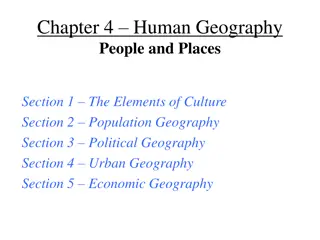Understanding Regions in Geography
Regions in geography are defined by common features such as climate, landscape, language, or religion. They serve as basic units of geography, with the Middle East being a notable example encompassing political, environmental, and religious characteristics. Regions can be classified based on physical or cultural criteria, with boundaries and spatial extent playing key roles in defining them. Physical regions are distinguished by singular characteristics like landforms or vegetation, while cultural regions reflect shared social or economic elements.
Download Presentation

Please find below an Image/Link to download the presentation.
The content on the website is provided AS IS for your information and personal use only. It may not be sold, licensed, or shared on other websites without obtaining consent from the author. Download presentation by click this link. If you encounter any issues during the download, it is possible that the publisher has removed the file from their server.
E N D
Presentation Transcript
What is a region A region is an area of land that has common features. These features can be natural, such as climate or landscape. They can also be artificial, such as language or religion. Regions, large or small, are the basic units of geography. The Middle East is considered a political, environmental, and religious region that includes parts of Africa, Asia, The region is in a hot, dry climate. Although the styles of government are varied (democracy in Israel and Syria, monarchy in Saudi Arabia), almost all of them have strong ties to religion. The region is where three of the world s major religions were founded: Christianity, Judaism, and Islam. Regional geography studies various world regions as they compare with the rest of the world.
What is a region Main criteria that define regions. They are cultural, (population regions, (ii) linguistic regions) Physical, (climatic region, relief region) Admistrative, (provincial district etc.) Socio-economic,( agricultural regions, industrial region, transport and trade regions. Religion, middle east, etc The number of regions may be enormous and vary greatly, they may all share certain common characteristics which are given below:
Attributes of Region Attributes of Region (i) Regions have location and spatial extent All region physical or cultural are often expressed in the regional name such as the Middle East, the South-East Asia, the North-West Europe, the Far East, etc. 2 Regions have boundaries Regions may be either formal or functional Regions have transitional boundaries
Classification of Regions: Classification of Regions: The regions may be classified as under: (i) Regions based on physical characteristic. (ii) Regions based on cultural characteristics.
(i) Physical Regions: The simplest of all regions to define, and easiest to recognize is the formal region based on a single variable or single characteristic. The island is land, not water, and its unmistakable boundary is naturally given where the one element (land) passes to the other (water). The dense forest may break dramatically upon the open grassland. The nature of change is singular and apparent. The physical geographers, who explain the natural environment, generally deal with single factor formal regions. Many of the earth features (physical features) do not exist in simple, clearly defined units. They must be arbitrarily and statistically demarcated or regionalized by the application of boundary definition. For example, the rainfall regions, the variability of rainfall regions, the plants association regions, soil regions (black-earth region of India), etc., must be decided on as regional limits and all such limits are subject to change through time or by purpose of the regional geographer. These regions and their boundaries change with the passage of time
(a) Landform regions: The landform regions are classified and demarcated on the basis of structure, relief, configuration, genesis and age. These regions are independent of human influence and unaffected by time on the human scale. Landforms constitute basic, naturally defined regions of physical geographic concern. The Himalayan system, the Vindhyan system, the Aravalli system, the Alpine system, the Kashmir valley, the Brahmaputra valley, plateaus and mountains, humid landform areas, dry landform areas, and glacial areas are some of the examples of the landforms regions. The landforms regions are the result of the internal and external physical forces. These have a close influence on climate, natural vegetation, and soils. The basic human activities are also largely influenced by the landforms regions.
(b) Climate region: A specific area in various combinations of climatic elements (temperature, rainfall etc.) may be recognized as a climatic region. Numerous attempts have been made to identify and classify climatic regions: (a) based on latitudinal temperature zones, we have the torrid, temperate, and frigid zones; and (b) based on temperature, rainfall and climatic effects, we have Koppen s, Thornthwait s and Miller s climatic regions. Although weather deals with the state of atmosphere over short duration, regions may also be recognised on the basis of weather conditions. For example, the air mass region or air masses.
Some of the important cultural regions are: (i) population regions, (ii) linguistic regions, (iii) religious regions, (iv) agricultural regions, (v) industrial regions, and (vi) transport and trade regions. , political regions























